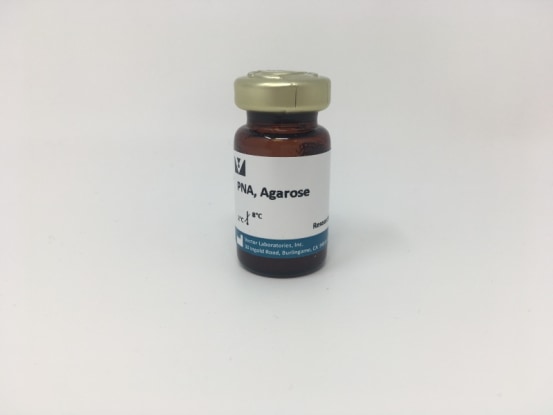Agarose Bound Peanut Agglutinin (PNA)
Product code : VEC.AL-1073-2 VEC.AL-1073-2
Peanut agglutinin binds preferentially to the T-antigen, a galactosyl (β-1,3) N-acetylgalactosamine structure present in many glycoconjug…

Packaging Unit
You can contact us for more information via the button “quote request'
Agarose Bound Peanut Agglutinin (PNA)
Product description
Peanut agglutinin binds preferentially to the T-antigen, a galactosyl (β-1,3) N-acetylgalactosamine structure present in many glycoconjugates such as M and N blood groups, gangliosides, and many other soluble and membrane-associated glycoproteins and glycolipids. With certain exceptions, the receptor sequence for PNA is normally sialylated which prevents the lectin from binding to its receptor oligosaccharide (see Jacalin). Even sialic acid which is not bound directly to the receptor sugars may inhibit binding. The presence of calcium ions in diluents can enhance the binding of PNA to receptors, possibly by neutralizing the negative charges on sialic acid residues adjacent to the receptor sequence.
PNA is useful in distinguishing between normal and tumor tissues and in assessing malignancy in transitional mucosa. In addition, PNA binding can be used to measure cellular maturity in lymphoid tissues, to distinguish a variety of lymphocyte subpopulations in man and experimental animals, and to measure the levels of lymphoid cell populations in many diseases. PNA can be employed in the fractionation of stem cells in mice for use in bone marrow transplantation across histocompatibility barriers.
A major cell surface receptor for PNA may be asialo GM1 ganglioside. Since PNA shares specificity with the antibody to this glycolipid, PNA and the antibody can be used interchangeably in some applications.
Agarose bound* PNA is prepared using our affinity-purified lectins. Heat stable, cross-linked 4% agarose beads with a molecular weight exclusion limit of about 2x107 daltons are used as the solid-phase matrix to which the lectins are covalently coupled. The attachment of the lectins to the beads is carefully controlled to preserve lectin activity and minimize conformational changes of the bound lectins that might result in nonspecific ionic or hydrophobic interactions. The technique we have developed to couple lectins to agarose beads inserts a hydrophilic spacer arm between the lectin and the matrix.
This coupling method provides several advantages over the traditional cyanogen bromide procedure:
- Maximum carbohydrate binding activity of the coupled lectins is retained
- Linkage is stable over a range of pH values
- Conjugated proteins are not leached off the beads by Tris or other routinely used buffers
- No residual charges are present after conjugation. This minimizes non-specific binding to the matrix.
Our agarose bound lectins are supplied at a constant concentration of lectin per ml of settled beads. The concentration for each lectin is selected to achieve the highest glycoconjugate binding capacity per mg of lectin present in the beads. Each lot is tested for its binding capacity using glycoproteins known to bind the lectin. This provides a guideline for the user and assures the quality of our agarose bound lectins.
Inhibiting/Eluting Sugar: 200 mM galactose
*5 mg lectin/ml gel
Agarose Bound Peanut Agglutinin (PNA)
Product specifications
Packaging Unit
2 ml
Brand
Vector Laboratories
Category
Lectin
Agarose Bound Peanut Agglutinin (PNA)
Product documents

